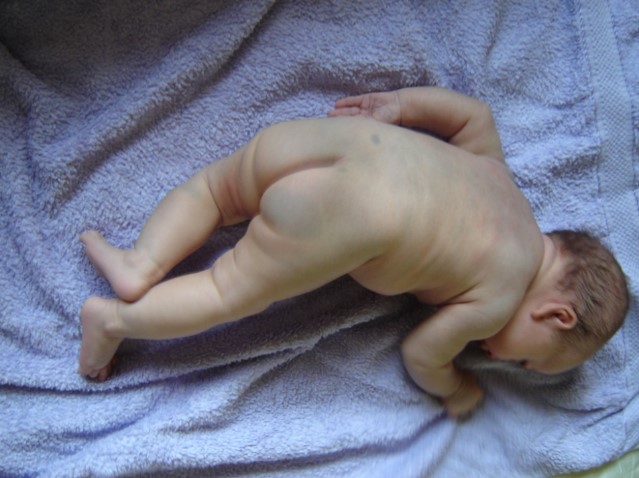Mongolian spot
DOI:
https://doi.org/10.7577/radopen.1198Keywords:
Birthmark, Child abuse, Mongolian spot, Skin signsAbstract
Colorful skin spots on a pediatric patient can easily be mistaken as signs of child abuse. Professionals should therefore gain knowledge about Mongolian spots; also known as Mongolian blue spots. These are flat, congenital and benign birthmarks, commonly located in sacro-coccygeal or lumbar area of an infant. Child abuse is a major public health problem across the world. The most common manifestations of physical child abuse are cutaneous, and their recognition and differential diagnosis are of great importance. Mongolian spots may appear as signs of child abuse; however, Mongolian spots are harmless.References
Ashrafi, M. R., Shabanian, R., Mohammadi, M., & Kavusi, S. (2006). Extensive Mongolian Spots: A Clinical Sign Merits Special Attention. Pediatric Neurology, 34(2), 143-145. http://dx.doi.org/10.1016/j.pediatrneurol.2005.07.010
Ayten Egemen, T. İ., Serap Ergör, Gülgün Mete Asar, Özge Yılmaz (2006). Frequency and characteristics of Mongolian spots among Turkish children in Aegean region. The Turkish Journal of Pediatrics, 48(3), 232-236.
Baelz.E. (1885). Die koerperlichen Eigenschaften der Japaner. . Mittheil.d.deusch Gesell.f.Natur-u-Voelkerheilkunde Ostasiens. Bd.4.H.32.
Cordova, A. (1981). The Mongolian spot: A study of ethnic differences and a literature review. Clinical Pediatrics. 20(11),714-719
http://dx.doi.org/10.1177/000992288102001105
Gupta, D., Thappa, D. M. (2013). Mongolian Spots-A Prospective Study. Pediatric Dermatology, 30(6), 683-688.
http://dx.doi.org/10.1111/pde.12191
Igawa, H. H., Ohura, T., Sugihara, T., Ishikawa, T., & Kumakiri, M. (1994). Cleft lip mongolian spot: Mongolian spot associated with cleft lip. Journal of the American Academy of Dermatology, 30(4), 566-569.
http://dx.doi.org/10.1016/S0190-9622(94)70063-X
James WD, B. T., Elston DM, eds. . (2011). Andrews' Diseases of the Skin: Clinical Dermatology (. Ed. Vol. Chapter 28). Philadelphia: Saunders Elsevier.
Leung, A. (1988). Mongolian spots in Chinese children. International Journal of Dermatology, 27(2),106-108.
http://dx.doi.org/10.1111/j.1365-4362.1988.tb01282.x
Numabe, H. (2003, 2003). Spotting Mongolian Spots [Child Fleck] Birthmark. NOT Bruise. NOT Abuse. About Mongolian Spots. Examples of Mongolian Spots. Differential Diagnosis. . Retrieved 28.10., 2014, from http://www.tokyo-med.ac.jp/genet/msp/index.htm
Reza, A. M., Farahnaz, G.Z., Hamideh, S., Alinaghi, S.A.S., Saeed, Z., Mostafa, H. (2010). Incidence of mongolian spots and its common sites at two university hospitals in Tehran, Iran. Pediatric Dermatology, 27 (4), 397-398.
http://dx.doi.org/10.1111/j.1525-1470.2010.01168.x
Nam, Seung Woo; Ko, Sun Young; Lee, Yeon Kyung, Shin, Son Moon, and Kim, En Hyung (2014). The Incidence of Birthmarks in Korean Newborn Infants. Neonatal Medicine, 21(3):151-157
http://dx.doi.org/10.5385/nm.2014.21.3.151
Ayten Egemen, T. İ., Serap Ergör, Gülgün Mete Asar, Özge Yılmaz (2006). Frequency and characteristics of Mongolian spots among Turkish children in Aegean region. The Turkish Journal of Pediatrics, 48(3), 232-236.
Baelz.E. (1885). Die koerperlichen Eigenschaften der Japaner. . Mittheil.d.deusch Gesell.f.Natur-u-Voelkerheilkunde Ostasiens. Bd.4.H.32.
Cordova, A. (1981). The Mongolian spot: A study of ethnic differences and a literature review. Clinical Pediatrics. 20(11),714-719
http://dx.doi.org/10.1177/000992288102001105
Gupta, D., Thappa, D. M. (2013). Mongolian Spots-A Prospective Study. Pediatric Dermatology, 30(6), 683-688.
http://dx.doi.org/10.1111/pde.12191
Igawa, H. H., Ohura, T., Sugihara, T., Ishikawa, T., & Kumakiri, M. (1994). Cleft lip mongolian spot: Mongolian spot associated with cleft lip. Journal of the American Academy of Dermatology, 30(4), 566-569.
http://dx.doi.org/10.1016/S0190-9622(94)70063-X
James WD, B. T., Elston DM, eds. . (2011). Andrews' Diseases of the Skin: Clinical Dermatology (. Ed. Vol. Chapter 28). Philadelphia: Saunders Elsevier.
Leung, A. (1988). Mongolian spots in Chinese children. International Journal of Dermatology, 27(2),106-108.
http://dx.doi.org/10.1111/j.1365-4362.1988.tb01282.x
Numabe, H. (2003, 2003). Spotting Mongolian Spots [Child Fleck] Birthmark. NOT Bruise. NOT Abuse. About Mongolian Spots. Examples of Mongolian Spots. Differential Diagnosis. . Retrieved 28.10., 2014, from http://www.tokyo-med.ac.jp/genet/msp/index.htm
Reza, A. M., Farahnaz, G.Z., Hamideh, S., Alinaghi, S.A.S., Saeed, Z., Mostafa, H. (2010). Incidence of mongolian spots and its common sites at two university hospitals in Tehran, Iran. Pediatric Dermatology, 27 (4), 397-398.
http://dx.doi.org/10.1111/j.1525-1470.2010.01168.x
Nam, Seung Woo; Ko, Sun Young; Lee, Yeon Kyung, Shin, Son Moon, and Kim, En Hyung (2014). The Incidence of Birthmarks in Korean Newborn Infants. Neonatal Medicine, 21(3):151-157
http://dx.doi.org/10.5385/nm.2014.21.3.151

Downloads
Published
2014-12-01
How to Cite
Bista, R., & Pandey, P. (2014). Mongolian spot. Radiography Open, 1(1), 6. https://doi.org/10.7577/radopen.1198
Issue
Section
Articles
License
Authors who publish with this journal agree to the following terms:- Authors retain copyright and grant the journal right of first publication, with the work after publication simultaneously licensed under a Creative Commons Attribution License that allows others to share the work with an acknowledgement of the work's authorship and initial publication in this journal.
- Authors are able to enter into separate, additional contractual arrangements for the non-exclusive distribution of the journal's published version of the work (e.g., post it to an institutional repository or publish it in a book), with an acknowledgement of its initial publication in this journal.
- Authors are permitted and encouraged to post their work online (e.g., in institutional repositories or on their website) prior to and during the submission process, as it can lead to productive exchanges, as well as earlier and greater citation of published work (See The Effect of Open Access).



